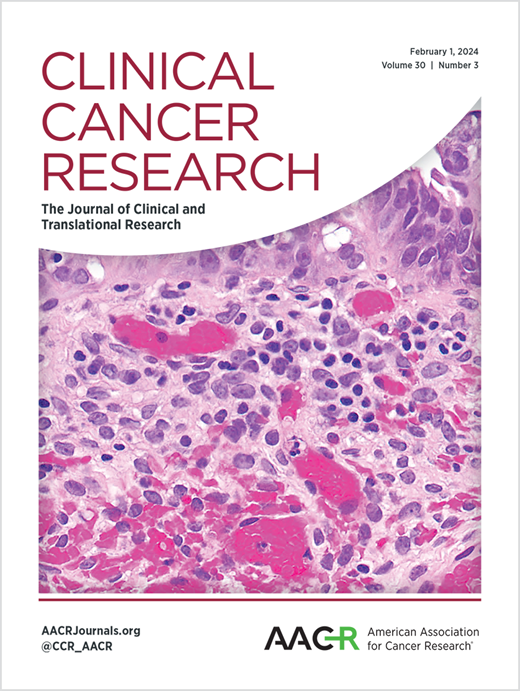局部骨肉瘤的肿瘤免疫微环境相关预后和米法莫肽反应基因特征:ISG/OS2试验的相关研究
IF 10.2
1区 医学
Q1 ONCOLOGY
引用次数: 0
摘要
ISG/OS-2试验评估了米法莫肽在p -糖蛋白(Pgp)阳性的局部骨肉瘤患者中的应用。主要目的是根据肿瘤免疫微环境(TME)基因谱在所有患者和接受米福莫肽治疗的患者中确定预后分类器。实验设计利用胰腺癌免疫谱分析小组(NanoString Technologies, Seattle, WA, US)分析了62例患者治疗前FFPE非脱钙组织中的rna。62例pgp阳性患者中有33例(53%)接受化疗(CT)+米福莫肽,62例pgp阴性患者中有29例(47%)单独接受CT。采用单因素Cox回归、ROC曲线和CIBERSORTx算法进行基因反卷积分析。结果tsa 21基因标记能够将所有患者分为高危(Hi-R)和低危(Lo-R): Hi-R患者的5年OS为47%;92%为Lo-R (p = 3e-06)。在CD8 T细胞、T-regs和NK活化细胞中,Lo-R与Hi-R的TME显著富集,而在CD4 T细胞中,TME显著降低。在Target-OS TCGA (n=62)和GSE33382 (n=57)两个独立的集合中验证21个基因的特征。对于CT+米福莫肽治疗的患者,还鉴定出31个米福莫肽相关基因能够区分OS (p = 1e-09)和EFS (p = 3e-06)的Hi-R和Lo-R。多变量分析后,21基因和31基因米法莫肽相关特征与OS独立相关(p= 0.00044和p= 0.000079)。结论经sa验证的骨肉瘤TME预后基因特征已被确定,与米法莫肽治疗无关。重要的是,还开发了与米法莫肽相关的签名。肿瘤免疫相互作用可能与疾病进展和治疗反应有关。本文章由计算机程序翻译,如有差异,请以英文原文为准。
Tumor immune microenvironment-associated prognostic and mifamurtide-response gene signatures for localized osteosarcoma: a correlative study of the ISG/OS2 trial.
PURPOSE
A risk-adapted treatment strategy, the ISG/OS-2 trial, evaluated the use of mifamurtide in P-glycoprotein (Pgp)-positive localized osteosarcoma patients. The primary objective was the identification of prognostic classifiers based on tumor immune microenvironment (TME) gene profiling in all patients and in those undergoing mifamurtide.
EXPERIMENTAL DESIGN
RNA from pre-treatment FFPE non-decalcified tissues of 62 patients was analyzed with the PanCancer Immune profiling panel (NanoString Technologies, Seattle, WA, US). Thirty three out of sixty-two (53%) Pgp-positive patients underwent chemotherapy (CT)+mifamurtide, 29/62 (47%) Pgp-negative patients received CT alone. Univariate Cox regression, ROC curve and CIBERSORTx algorithm gene deconvolution analyses were performed.
RESULTS
A 21-gene signature able to stratify all patients into high-(Hi-R) and low-risk (Lo-R) was identified: 5-year OS for Hi-R 47%; 92% for Lo-R (p = 3e-06). TME of Lo-R vs Hi-R, was significantly enriched in CD8 T-cells, T-regs, and NK activated cells, and diminished in CD4 T- cells. The 21-gene signature was validated in two independent sets: Target-OS TCGA (n=62) and GSE33382 (n=57). For patients treated with CT+mifamurtide 31-mifamurtide related genes able to distinguish Hi-R and Lo-R in terms of OS (p = 1e-09) and EFS (p = 3e-06) were also identified. After multivariate analysis the 21-gene and the 31-gene mifamurtide-related signatures were independently associated with OS (p= 0.00044 and p = 0.000079, respectively).
CONCLUSIONS
A validated osteosarcoma TME prognostic gene signature has been identified, regardless of mifamurtide treatment. Importantly, a mifamurtide-related signature was also developed. Tumor-immune interactions possibly implicated in disease progression and treatment response were shown.
求助全文
通过发布文献求助,成功后即可免费获取论文全文。
去求助
来源期刊

Clinical Cancer Research
医学-肿瘤学
CiteScore
20.10
自引率
1.70%
发文量
1207
审稿时长
2.1 months
期刊介绍:
Clinical Cancer Research is a journal focusing on groundbreaking research in cancer, specifically in the areas where the laboratory and the clinic intersect. Our primary interest lies in clinical trials that investigate novel treatments, accompanied by research on pharmacology, molecular alterations, and biomarkers that can predict response or resistance to these treatments. Furthermore, we prioritize laboratory and animal studies that explore new drugs and targeted agents with the potential to advance to clinical trials. We also encourage research on targetable mechanisms of cancer development, progression, and metastasis.
 求助内容:
求助内容: 应助结果提醒方式:
应助结果提醒方式:


